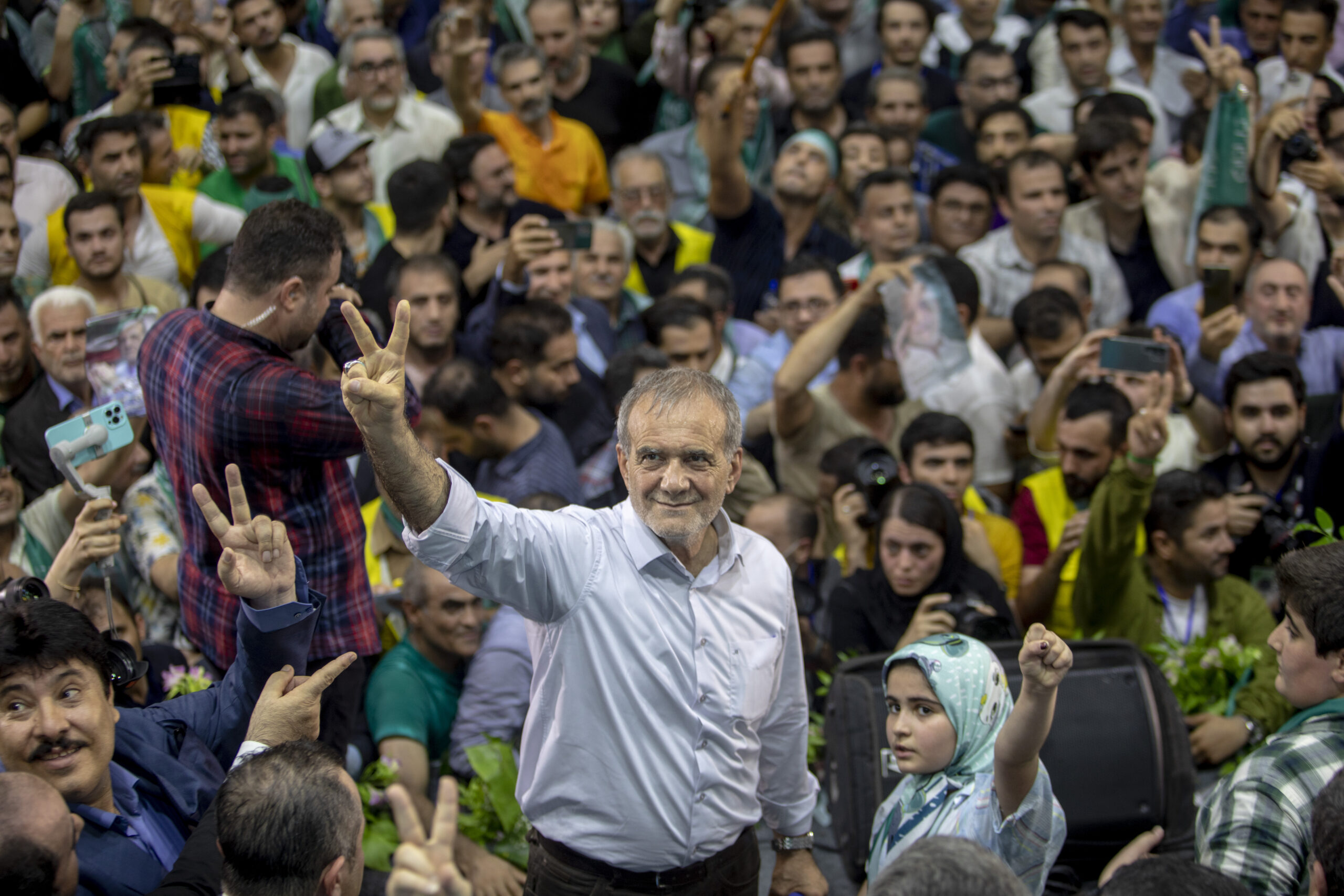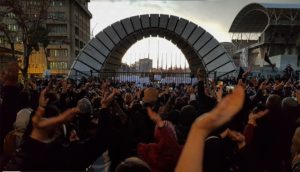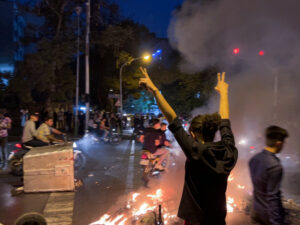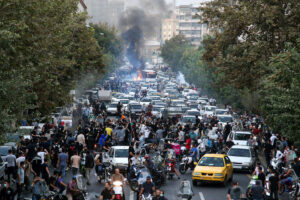
Masoud Pezeshkian won’t be a “reformer” in any genuine sense. Like all Iranian presidents, he has pledged his loyalty to Iran’s supreme leader. What he really offers is a softer version of Iran’s grim repression.
July 2024
On July 5, Iranians “elected” cardiac surgeon and former health minister Masoud Pezeshkian, a so-called reformist, to replace the late hardliner president Ebrahim Raisi, who died in a helicopter crash in May. Pezeshkian defeated the “conservative” (or “principalist”) candidate — supposedly the one most strongly committed to the Islamic regime’s ideological orthodoxy. But make no mistake: No matter the winner, Iran’s supreme leader, Ayatollah Ali Khamenei, is still the unquestioned ruler of the Iranian regime.
Should there be any doubt, in the run-up to the vote, both candidates repeatedly declared their total obedience to Khamenei. The supreme leader directly controls the military and security forces as well as the judiciary and, through his veto power, the parliament; he indirectly controls the executive with his power to validate elections and by supervising the president, whose prerogatives are merely administrative. Separation of powers in the Islamic Republic is an illusion.
In this absolutist theocracy, where God is the sole sovereign according to the constitution, does the election really matter?
Voting in Iran was never meant to be a process that embodies the people’s sovereignty within the political system. The 1979 Constitution lays out a different conception: Only God is sovereign. His sovereignty is exercised by a supreme leader and carried out by unelected bodies, such as the Guardian Council, with the power to vet and disqualify election candidates and to veto bills produced by elected bodies such as the parliament.
Unelected bodies control every facet of elections – from deciding who can run to deciding who can win. This broad vetting authority has been used to exclude not only all opposition figures and dissidents but even once-acceptable members of the ruling elite, including four former presidents. Such strict control, however, does not mean that there won’t be vote rigging. Should the public vote overwhelmingly for a candidate other than the intended winner, authorities can resort to ballot tampering. They did so in the 2009 presidential contest and in other elections before that. In the 2000 parliamentary elections, for instance, when former president Ali Akbar Hashemi Rafsanjani (d. 2017) lost his race to become a Tehran MP, the regime padded his vote count and declared him a deputy. Offended by the low vote share he was allotted, however, he renounced his mandate. Ironically, the Guardian Council would go on to bar Rafsanjani from running for president in 2013.
Pezeshkian acknowledged in his victory speech that, were it not “for the supreme leader, [his] name wouldn’t have come out of the ballot box.” The president-elect’s political program therefore conforms with Khamenei’s directives, which are clear. “Any government that comes into office,” Pezeshkian has said, “must implement its development plans based on these declared general policies [of] the leader of the revolution.” Plans that deviate would thus violate the president-elect’s red line.
So how does Pezeshkian reconcile certain positions he campaigned on with that red line? Mostly by resorting to rhetorical contortionism. He claimed, for example, to support women’s rights. Yet the purported reformist is an Islamist militant who, as a Khomeinist revolutionary in charge of purges in hospitals and universities, actively enforced the coerced veiling of women in the wake of the 1979 revolution. He has not clarified what he means by “women’s rights,” but he has suggested that if women oppose wearing a veil, it is the fault of the regime for having failed to successfully indoctrinate them. This view, of course, implies that women do not have the right to refuse to veil. Pezeshkian proposes keeping the mandatory hijab in place, but enforcing it in a kinder, more polite manner.
Similarly, he advocates abolishing internet filtering because of the economic and scientific benefits of a free internet. Yet he also points out that the current massive use of VPNs to evade filtering deprives the state of the means to control citizens’ internet use. Pezeshkian has also said that the government should be able to completely shut down the internet during strikes and popular protests, as it did in 2019 while security forces were killing peaceful protestors.
The president-elect has repeatedly pledged to fight corruption, and he has promised to halt the sacking of university professors and students for their opinions. But he does not advocate any policy likely to extend citizens’ civil or political rights. All in all, he promises a gentler form of repression. And even this is a hollow promise, as he has no power over what the security forces and judiciary do.
The Election Trap
Knowing all this, one might be tempted to dismiss Iran’s elections as merely symbolic. But that would be a mistake. These contests serve to bolster the state’s domestic and international standing. The people have no say in the political, social, and economic programs implemented by elected officials, so their participation at the polls assumes a different political function: As Khamenei spelled out in 2017, “When [those] who [are] discontent with the system come to vote, it means they accept the framework . . . . Voting in the elections is a vote for the system and a sign of trust in it.” He similarly urged voters to go to the polls this year, stating that “the endurance of the Islamic Republic, the strength of the Islamic Republic, the dignity of the Islamic Republic, and the reputation of the Islamic Republic in the world depend on the people’s participation in the elections.”
By voting, citizens inadvertently endorse a regime that denies them sovereignty and thereby become complicit in their own oppression. Iran’s clerical rulers view this electoral ritual as a reaffirmation of popular faith in the entire system. A higher turnout thus strengthens the regime’s authority over citizens, boosts its confidence on the global stage, and emboldens it in its ongoing struggle against liberal democracy.
From 1989 to 2017, citizens participated in elections with hopes merely of electing the least bad candidate and improving social and economic conditions in the country. This unspoken bargain between the state and society became uncertain after the 2009 Green Movement crisis, however, when the victory of voter favorite Mir Hosein Musavi was denied. Still, Iranians went to the polls again in 2013 and 2017 to vote for the “moderate” Hassan Rouhani, mainly to support the de-escalation of international tensions and improve relations with the United States. It was fear, not hope, that motivated their participation: fear of war, fear of more repression, and fear of growing economic hardship.
In December 2017, just a few months into Rouhani’s second term, massive protests against the high cost of living broke out across Iran. They were violently crushed; but one of the protest slogans — “reformist versus principalist [conservative], this game is over” — signaled that the relationship between the regime and the people was about to change. In November 2019, mass protests against rising gas prices met with even more ferocious repression. Rouhani’s government shut down the internet, and security forces killed hundreds, and perhaps more than a thousand, demonstrators. Several weeks later, when the Islamic Revolutionary Guard Corps “mistakenly” fired missiles at a civilian aircraft, killing 176 people, protests again erupted and again were brutally put down.
Iranians are massively connected to the internet (almost 79 percent of the population goes online) and well informed about the repression, and they witnessed firsthand the country’s steadily deteriorating social and economic conditions. So they realized that the theocracy’s election bargain had been deceptive. In the aftermath of the 2017 and 2019 mass protests, people began to rethink how they should approach elections.
To Vote or Note to Vote
For decades, public debate around voting focused on deciding who was the lesser evil among the regime’s vetted candidates. There was little, if any, discussion of boycotting elections. That changed in 2021, when a major social-media campaign, which was actively backed by friends and relatives of victims of state repression, urged Iranians to boycott the presidential vote. Raisi, the hardliner candidate, won that year.
The unverified official turnout of 48.8 percent was the lowest in the history of the regime’s elections, with a staggering 13 percent of ballots being spoiled, invalid, or lost. In all likelihood, the real turnout was even lower, as a reliable independent survey had predicted it would be just around 30 percent. More important, in the same survey 66 percent of nonvoters reported “the unfree and ineffective nature of elections” as their reason for abstaining. The regime could no longer lure voters to the polls with its lesser-evil bargain.
Turnout was the main issue this year as well. Some high-profile reformist notables, including former president Mohammad Khatami, who had boycotted previous elections, advocated voting this year, prompting a heated debate on abstention.
Boycott calls echoed inside and outside Iran — among ordinary people, artists, and intellectuals, workers and teachers, in prisons, and unanimously among the often divided opposition in exile, as well as from justice-seeking relatives of slain protestors. In the vein of Czech dissident-turned-president Václav Havel, boycott supporters argued that, in totalitarian regimes, elections are a trap that strengthen the oppressors’ iron grip.
Iranian Nobel laureate Nargess Mohammadi wrote in a message from prison that she would not vote for a regime that was wielding “a sword, gallows, weapons, and prisons against the people with one hand,” and “plac[ing] a ballot box in front of the same people with the other.” Another high-profile political prisoner, the activist Bahareh Hedayat, lambasted reformists for advising people to vote and encouraged ordinary Iranians who had resisted the regime in the past by boycotting elections to do so again.
Recalling the words of Havel, 520 teachers issued a boycott statement explaining why they would abstain from voting: “Elections in the Islamic Republic have been stripped of their true meaning, which is the expression of the people’s will and desire. They have merely become a political ritual for introducing individuals approved by the regime. Participation in such elections, regardless of which candidate’s name is announced as the winner, is nothing but an acceptance and endorsement of the current imposed situation and an insult to the social intelligence of the people.”
Turnout was so low in the first round on June 28 that the government had to content itself with announcing an unverifiable 40 percent participation rate. It claimed that the second-round turnout was 49.8 percent. The accuracy of either number is unlikely.
Whatever the real figures, what matters most — for the people and the supreme leader — is that citizens are no longer complying with the regime’s sham electoral exercises. By withholding their ballots, a huge share of Iranian voters have, since 2021, been consistently subverting one of the main functions of elections within the theocratic system: that of making citizens complicit in the denial of their own rights. No matter how much the numbers are manipulated, the totalitarian regime knows its defeat and the people know their victory.
As for the other function, creating the optical illusion of a democratic Iran for the international community and improving the regime’s standing on the international stage, it will be up to the people’s democratic allies abroad to learn from the Iranian voters and resist the deception.![]()
Ladan Boroumand is a historian and the cofounder and senior fellow at the Abdorrahman Boroumand Center for Human Rights in Iran. She is currently writing a book on the tectonic social changes taking place within the Islamic Republic of Iran.
Copyright © 2024 National Endowment for Democracy
Image credit: Majid Saeedi/Getty Images
|
FURTHER READING |
||

Iranians Turn Away from the Islamic RepublicIran is in the midst of an ideological crisis. Growing numbers of Iranians are rejecting the religious underpinnings of the Supreme Leader’s rule, and turning their backs on the Islamic Republic. The regime’s only response is harsher repression — a response that will deepen the anger that is bringing everyday Iranians out into the streets. |

Why Women Are Leading the Fight in IranIran’s women were the Islamic Republic’s first target for repression. This is the newest chapter in their struggle to win back their rights. |

Is Iran on the Verge of Another Revolution?There have been numerous waves of protest against the country’s corrupt theocracy. This time is different. It is a movement to reclaim life. Whatever happens, there is no going back. |
